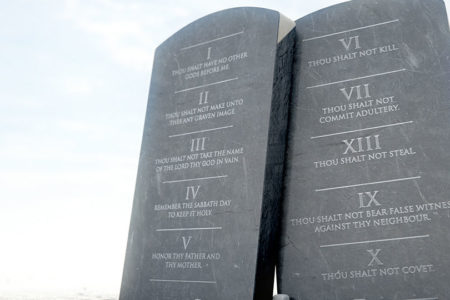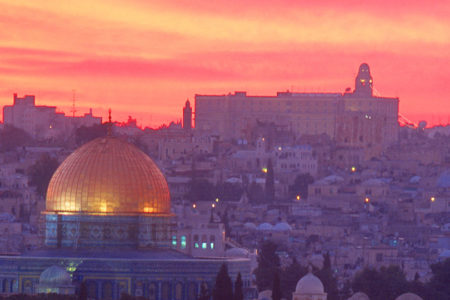Israel in the News Sep/Oct 2005
Settlers’ Things to be Left Behind
ARUTZ-7—An outstanding issue in the ever-so-complicated disengagement/expulsion is what to do with the residents’ property. “What-ever we can fit into two large containers, we will take,” army Brig.-Gen. Guy Tzur told the people of Gush Katif, “and the rest we will simply leave behind.”
“Whoever stays after the date set by the government, August 15, will have some of their property packed by the army, and the rest of it will remain,” the officer said. “After the residents are taken out, whatever is on the floor [chairs, tables, etc.] we will take, and whatever is not, such as pictures on the wall and air conditioners, we will leave behind.”
Benny Yefet, whose son Itamar was murdered by Palestinian terrorists in Gush Katif almost five years ago, called out, “Sure, it would truly be a good idea to leave behind the picture of my son for his murderers who will receive my house.”
Another woman called out, “Who’s talking about air conditioners? We’re talking about something very different; we’re talking about the values that you taught our sons in the army officers’ courses, about the Land of Israel and the People of Israel.”
Anita Tucker of Netzer Hazani said they had learned there are no housing solutions for them for a month. At that, Gen. Tzur pulled a piece of paper from his pocket and began to read, “I met with Bassi, and he told me that there are solutions for everyone. There are 300 caravilot [new mobile homes of 60 and 90 square meters (72 and 107 square yards)] in Nitzanim, for instance.” He also said apartments are available.
Tucker told Arutz-7, “We told him that there are 420 people already signed up for those 300 caravilot. We told him that there was going to be a lottery for the caravilot, which means that some of those who think they have a solution, really do not! And certainly Netzer Hazani would not be able to go as one bloc, which all the experts said all along is critically important. He said that it was our fault for not meeting earlier, etc., and we told him that we had met with lots of people, and that the idea of Nitzanim had come from our representatives in the first place!
“Gen. Tzur said that the expectation is that only 20 percent of the population will actually remain in Gush Katif by August 15, such that the problem would not be as critical as we were describing,” Tucker recounted. “We told him, ‘Wake up! Do you know how many people are here already?’”
The official population of Gush Katif is approximately 8,000, but some estimates are that close to 11,000 people, including entire high school and yeshiva classes from around the country, live there.
IDF to Blow Up Katif Synagogues
ARUTZ-7—How do you dismantle entire communities? The Defense Ministry acknowledges that one of the possibilities for the synagogues and yeshivot in Gush Katif is to blow them up.
The decision to destroy all the houses scheduled to be evacuated in Gush Katif and northern Shomron appears final. When U.S. Secretary of State Condoleezza Rice visited Israel recently, she reached an “agreement in principle” that the Israelis would destroy the houses and then pay the Palestinian Authority (PA) to deal with the rubble. The PA, however, has apparently reneged on the deal, and Israel is negotiating with Egypt over a plan to bury the rubble—an estimated 60,000 truck-loads’ worth—in the Sinai Desert.
The army plans to bulldoze the buildings, as it did in Yamit in 1982. Bulldozing the large buildings, such as synagogues, might take too long, however, and the army is therefore likely to blow them up. Close to 30 synagogues and religious schools are at stake.
Army rabbinate officials will first catalog and remove all items from the synagogues, including holy books and possibly furniture.
Plans are also being made regarding the 48 graves in Gush Katif. Relatives of the deceased have refused to allow the exhumation of the bodies, but there is no chance the bodies will be left behind if the expulsion becomes fact.
Left-Wing Writer Moves Right
ARUTZ-7—A veteran left-wing columnist wrote that he now realizes disengagement is a mistake because it will reward terrorism.
“Events from recent days raise fears that a unilateral withdrawal from Gaza is causing serious security damage to Israel,” Danny Rubenstein wrote. He added that Arabs see the planned withdrawal of the army from Gaza as proof that “Israel only understands the language of terror attacks and violence.”
Rubenstein’s comments come after weeks of warnings from several senior Israel Defense Forces officers that Arab terror will escalate after the Jewish residents abandon their homes and turn over more than 25 Jewish communities to the Palestinian Authority (PA).
Rubenstein wrote, “There does not seem to be a solution for this at the present, and the conclusion is that embittered and angry Hamas members in Gaza will continue and even intensify terror attacks and firing at Israeli targets. Hamas doesn’t mind making the Israeli withdrawal difficult or even torpedoing it.”
Danny Rubinstein has been writing on the Israel-Arab conflict for 30 years.
Mortars Still Fly
Nothing Israel does keeps the Palestinians from shelling Jewish homes in and around Gush Katif.
By mid-July the total number of mortar shells fired reached 5,865, with five more people wounded, two seriously.
The Jewish town of Netiv Ha’asara, within Israel’s pre-1967 border, was one of the targets.
The Case of Ma’aleh Adumim
Want to order pizza? Need to go to an Ace Hardware store? Or maybe you just need to withdraw money from an ATM machine before a trip to the library or mall. You can do all these things, just as you can in any thriving city, in Ma’aleh Adumim, ironically dubbed a “settlement” by the secular news media.
In April the Israeli government announced plans to build 3,500 more homes in the corridor between Jerusalem and Ma’aleh Adumim to link this bustling suburb of 32,000 residents directly to the capital city. And, of course, it is being told that doing so will impede the peace process.
Ma’aleh is located 4.5 miles east of Jerusalem in Judea (West Bank), the fruit of 23 pioneering families who moved to the dry, lifeless area inhabited by no one in 1975. By 1999 Ma’aleh Adumim, filled with stores, schools, factories, and more, opened a mall to accommodate its 25,000 residents.
Today it is a beautiful city with playgrounds, outdoor sculptures, 275 acres of green space, and magnificent views of Mount Scopus and the Mount of Olives.
despite the world’s attempts to strip Israel of its land, Prime Minister Ariel Sharon vowed before he left for talks at the White House in April, “Ma’aleh Adumim will remain part of the state of Israel forever and ever.”







